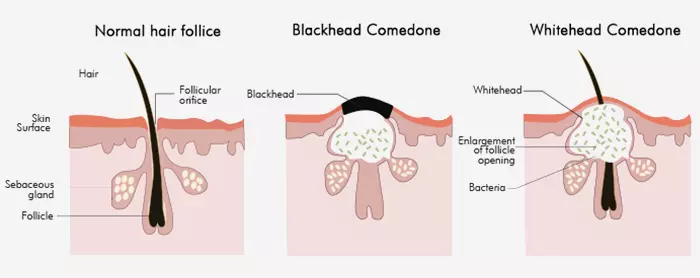Blackheads Vs. Whiteheads
skin can also experience whiteheads and blackheads, especially if they use heavy or occlusive Mild acne occurs when excess sebum, keratinous material, dead cells, and dirt clog the pores. This clogging allows bacteria to colonize the pores, leading to closed comedones or whiteheads. Further bacterial growth expands the whitehead, causing its tip to open up. The open tip oxidizes, turns black, and forms open comedones or blackheads. Let’s take a look at the differentiating factors between whiteheads and blackheads and treatment options.
1. Color
The term blackhead is self-explanatory as its tip appears black due to the oxidization of lipids and melanin. Whiteheads may appear white or flesh-colored.
2. Affected Area
Whiteheads can appear anywhere on the body, but they mostly occur on the T-zone as it has more oil glands. You may also notice whiteheads on your chest, back, shoulders, and arms. 85% of people experience acne vulgaris (open and closed comedones) during any point of their lifespan. However, it occurs mostly during adolescence. Blackheads can form anywhere on the body except the palms and soles (including the back, chest, shoulders, arms, and thighs) but commonly on the nose and chin. However, there are many treatment options available if you have whiteheads on your nose. The same goes for blackheads. Here are the treatment options for minimizing blackheads and whiteheads.
Treatment Options
If you have questions like how to get rid of whiteheads on your face and how to remove deep blackheads, there are many ways that you can consider. Whiteheads and blackheads are mild forms of acne (grade 1) and are generally treated with topical retinol, salicylic acid, and benzoyl peroxide. Here are the treatment options for whiteheads and blackheads:
Benzoyl peroxide is used between the concentrations of 2.5% and 10% in anti-acne products. It is a comedolytic, keratolytic, anti-inflammatory agent with antimicrobial properties. It kills acne-causing bacteria and reduces inflammation. Salicylic acid is a desmolytic agent available in 0.5% to 2% strengths in OTC products. It dissolves the bond between dead skin cells to promote exfoliation and reduce acne. Retinol (like tretinoin and adapalene) is often used as a first-line treatment for mild-to-moderate acne. It is best to start this in consultation with your dermatologist as problems like purging are real and can be mentally challenging. Azelaic acid acts as a comedolytic, antimicrobial, and anti-inflammatory agent and helps reduce acne. However, it may also cause redness and burning sensations and irritate sensitive skin. You may also try pore strips to treat blackheads on the chin. While they offer temporary relief, pulling out the sebaceous filaments, they are short lasting until the pore gets filled again in a span of 2-3 days. You may try facial extraction to clear whiteheads and blackheads. Consult a trained dermatologist to undergo proper aseptic facial extraction. Medical facials like hydrafacials by trained therapists at nearby skin clinics is another effective way of tackling them. Trying this at home may injure the skin and cause scarring and pigmented spots.
A blogger shares her struggle with blackheads and provides tips on how to get rid of them. She discusses various methods, including the use of a deep cleansing mud pack mask, peel-off masks/pore packs, and the oil cleansing method. She mentions, “I find fighting blackheads to be a never-ending battle, it never dies! It still comes back again. However, through some trial-and-error, I have found some ways to reduce the number of blackheads and to maintain the overall complexion (i).”
Home Remedies For Blackheads
1. Honey and Cinnamon Mask:
What You Need
1 tablespoon of honey 1 teaspoon of cinnamon powder
How To Prepare
2. Green Tea Toner
What You Need
1 green tea bag 1 spray bottle Cotton pads (as needed)
How To Prepare Apart from bacterial infection, several other factors can contribute to acne formation. Let’s take a look.
Other Causes For Comedonal Acne
Stress and changes in sleep patterns can exacerbate acne. Diet can influence sebum composition and contribute to acne. It was noticed that the sebum in people with acne had low amounts of linoleic acid (which can only be acquired through diet). Too much of this acid may cause overproduction of sebum. Changes in dietary fat or carbohydrate intake may also alter sebum production and composition. Genetics has a role in the development of acne. If it runs in your family, you may develop acne. Changes in hormone levels can cause these glands to produce more sebum than your skin needs.
You can easily prevent blackheads and whiteheads with simple lifestyle and skin care habits. Here are a few tips.
Preventive Measures And Tips
Consume a healthy and balanced diet. Avoid processed and sugary products. This can keep your skin healthy and prevent development of sudden breakouts, particularly pre-period ones. Do not touch your face often. Your fingers touch multiple surfaces and may transfer the dirt and bacteria to the skin. Wash your face twice daily. Over washing can aggravate breakouts. ●Wear a gel-based non-comedogenic sunscreen at all times. Use oil-free and non-comedogenic products to reduce the risk of breakouts. Maintain personal hygiene. Wash your hair and skin regularly. Reduce your stress levels. Indulge in meditation, yoga, and regular exercise for better hormonal control. For severe stress, visit a therapist.
Is it OK to pop whiteheads? Popping whiteheads is fine as long as done appropriately. However, it is never a good idea to pop hard, red pimples beneath the skin. Is it OK to squeeze whiteheads? Popping whiteheads can be pretty enticing and pleasurable. Squeezing your whiteheads, on the other hand, is not a good idea. It can lead to various issues and even introduce bacteria into the whitehead opening.
Discover the differences between blackheads, whiteheads, and milia in this video. Learn how to identify and treat each type, for clearer and healthy-looking skin. Press play to get practical tips for an effective skincare routine.






